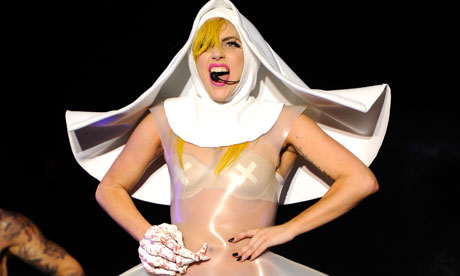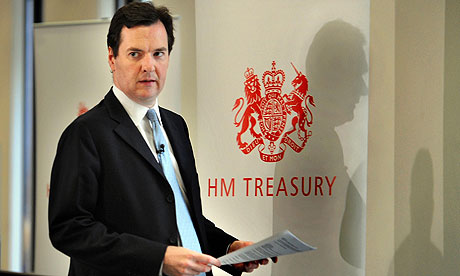Is the meat-wearing Bad Romance singer more than just another derivative pop star? Two of our writers tackle the Lady Gaga question – have your say below

Kira Cochrane: 'Lady Gaga exposes femininity as a sham'
The anticipated highlight of the show was – depressingly enough – a reheated argument. Before the MTV Video Music awards this year, all the talk was of whether pop princess Taylor Swift would address the debacle of 2009, when Kanye West barged on stage, interrupted her acceptance speech, and suggested Beyoncé should have won her award. Would Swift refer to this lightly in song? (She would. Yawn.) Would Kanye refer to this lightly in rap? (Not directly. Sigh.) So far, so stultifying.
And then, there she was. Lady Gaga, the big winner of the night, striding on stage in a dress made of meat. Or what looked like meat. Either way, there was the impression of sinews, fat, of oozing, bloody discharge. The outfit shouldn't have been a surprise. Just last week the singer was pictured on the cover of Japanese Vogue, dressed in a meat bikini. But what raises a mere eyebrow at a photoshoot can raise the roof, blood pressure and an avalanche of questions when worn in public. What did the meat dress mean? Was it a comment on the treatment of women in the music industry? Was it another of Gaga's death references? Did it reflect the boundaries of the body – representing Gaga's own flesh, turned inside out and extending beyond all expected limitations? Was it a comment on mutability? Or was it just an outfit worn to grab the maximum share of the world's attention?
In an interview with Ellen DeGeneres after the show, Gaga offered her own interpretation. She had come to the awards ceremony with four former servicemen and women, all of whom had been forced to leave the US military because of the highly discriminatory, horribly dated "Don't ask, don't tell" policy (you can be gay, says this policy, so long as you never, ever reveal it). Gaga suggested her dress had been part of that statement. "If we don't stand up for what we believe in," she said, "if we don't fight for our rights, pretty soon we're going to have as many rights as the meat on our bones." Then, as if she couldn't quite bear to pin herself down to a single meaning, she picked up a copy of Japanese Vogue, and pointed at the cover. "I am not a piece of meat," she said, with feeling.
The meat dress attracted attention at a time when Gaga's very unpredictability had begun to seem predictable, when her constant innovation had threatened to drag. Some of the writers and commentators I spoke to for this piece – many of whom love her – professed that they'd nevertheless become slightly weary of the newness, of the fact that every day Gaga would wear something, say something, do something that seemed primed to provoke a blog, an article, a comment. Shock will eat itself. And then, most of those same writers laughed and admitted the irony. None could name any other major pop star, or pop culture personality right now, who they could say the same about – any other artist who could stand accused on the grounds that they were just too impossibly inventive.
Gaga's latest outfit broke through that torpor, and revived questions that have circulated since she first appeared in the charts just two years ago. Who is the 24-year-old pop star formerly known as Stefani Joanne Angelina Germanotta? Is she a brilliant performance artist – or an empty provocateur? Is she driven by ideas, or neediness? Is she a feminist icon, or just a slightly offbeat sex object? Is she an important, influential artist who will endure – or another derivative desperado?
Camille Paglia has already been to work on some of these questions in a piece in the Sunday Times last weekend. It wasn't positive. She called Gaga a "ruthless recycler of other people's work", and suggested there was an "essential depressiveness and spiritual paralysis" about her. She compared her negatively with David Bowie, Madonna, Marlene Dietrich and Elton John. And what seemed to irk her most was what she considers Gaga's fundamental lack of sex appeal. "Gaga isn't sexy at all," she wrote. "She's like a gangly marionette or plasticised android. How could a figure so calculated and artificial, so clinical and strangely antiseptic, so stripped of genuine eroticism have become the icon of her generation? Can it be that Gaga represents the exhausted end of the sexual revolution? . . . Marlene and Madonna gave the impression, true or false, of being pansexual. Gaga, for all her writhing and posturing, is asexual."
What was interesting about Paglia's article was its implication that, in order to be a star – and particularly a female star – you have to be sexually appealing. This was underlined by her list of female singers she does admire. "Among the magnetic presences in music today," she wrote, "are tigresses of charismatic sensuality or gamines of buoyant charm – Beyoncé, Shakira, Rihanna, Lily Allen, Nelly Furtado." All of which apparently ignored the fact that, for her fans, one of Gaga's key attractions is precisely her dismissal of traditional, feminine sex appeal, of the need to be charming, of the values and aesthetic of other female singers: the ripe, pert bodies, the pretty, familiar costumes.
Of course, Gaga does sometimes embrace the iconography of traditional sex appeal. She often wears a basque, or other underwear, and vertiginously high heels; just this week, after the MTV awards, she wandered through an airport in bra, knickers, ripped fishnets and a gold leather jacket, a pair of handcuffs swinging from her waist. In her Telephone video – which attracted huge interest, but wasn't her finest hour – she danced in stilettos and a stars and stripes bikini, aping sexploitation films such as Faster Pussycat! Kill! Kill! a reference that just seemed worn and wearisome.
But for every bikini, for every batted eyelash, Gaga introduces intimations of the grotesque, the repulsive. The meat dress is an obvious case in point. As is her appearance at the end of the Bad Romance video, lying beside a smoking corpse, sparks putt-putting from her bra. And then there was her performance on The X Factor last year, singing that same song. She and her dancers gyrated in an enormous bath – so far, so kooky-but-palatable - and then Gaga perched on a toilet. I repeat: a toilet. There's almost nothing that could have been more subversive; as the feminist writer, Melissa McEwan, points out, "there is an episode of Sex and the City where Carrie isn't able to go to the bathroom in Big's apartment". For a singer – and, again, especially a female singer – to introduce these kind of references into a performance, in such a matter-of-fact way, with no wink or humour, was genuinely astounding.
In some ways, Gaga's entire persona seems to question what's expected of women. It's there in the internal contradiction of her name: "Lady" with its suggestions of gentility, sweetness, high breeding; "Gaga" with its intimations of infantility, madness, antic spirit. She has often been compared with a drag queen and, in many ways, this seems apt. Part of the brilliance and beauty of drag, of course, is that it can potentially expose sex roles – most often femininity – as a performance. A drag queen in enormous false eyelashes, teetering heels, a tight dress, heavy makeup, a voluminous wig, talon-like nails, is mimicking a woman, while underlining that what's expected of women is in no way natural. With her increasingly bizarre getups, Gaga does the same.
In fact, she exposes femininity as a sham in all sorts of ways. If the typically feminine woman is supposed to be simpering, seductive, weak, manipulated – essentially submissive – Gaga kicks against all these qualities. There have been suggestions that her fame, prominence and phenomenal success is based on the power and talent of the people she works with, that she's just a puppet of a corporate machine. But this seems highly unlikely. She has spoken of her early fights with her record label over her aesthetic, saying that "the last thing a young woman needs is another picture of a sexy pop star, writhing in sand, covered in grease, touching herself". As Dodai Stewart, writer and editor for feminist blog Jezebel.com says, "record labels are obviously corporate, the music industry is obviously corporate. But, for instance, I don't think that her appearing with the soldiers on the red carpet is manufactured. I think that that's consistent with what she's been saying from the beginning."
One of the other qualities that is always considered central to being a woman is a desire for a partner, love, romance. Gaga has made some surprising pronouncements on this front before – on one occasion she said that she believes "in certain institutions: cooking, serving dinner, taking care of my family. So I consider myself quite the lady." As McEwan notes though, there have been rumours of boyfriends, but "unlike Madonna, who has always famously lived with some guy, and everyone knows her husband, her boyfriend's name, and what they're doing, Gaga is really an entity unto herself. She's not famously partnered, which I think is remarkable. I've read occasionally that she's dating somebody, but I've never really paid attention to it, and neither has the press. I suspect that's because she's allowed to be independently sexual in a way that other young women aren't." Where Jennifer Aniston's single status is constantly picked over, Gaga has carved out a space where she can stand alone, and that loneliness actually heightens, rather than diminishes, her power.
This loneliness is also emphasised by her costumes, many of which act as exo-skeletons, essentially cages within which she performs. While most women in the spotlight are intent on appearing as small as possible – and Gaga is certainly physically tiny, a 5ft 2in stripling – her costumes are often bulky, lumpy, tough, hard, impenetrable. She has appeared encased in concentric metal hoola hoops, in a coat made of Kermits, a skirt made of a Muppet's head, a multitude of masks, studs, lace and latex, crowns and feathers and a massive lurex tent. McEwan sees these outfits as a commentary on female consent; a woman taking ownership of her body and keeping others at arm's length. "She's a performance artist," she says, "and a lot of what she does is physically representative of this outer shell. The gyroscope outfit was just ridiculously distancing – as was the time she wore the Kermit outfit. You couldn't hug her, even if you wrapped your arms around her. You wouldn't be anywhere close, because she wears these outfits that are physically distancing. I think that's an affected and deliberate look that says: you can't touch me . . . She's very positive about her fans, she reaches out to them, loves them, talks very fondly to them from the stage. But her suits of armour say that they can't just walk up and touch her. Nobody can."
Gaga's outfits are distancing and, in some ways, dehumanising. In fact, the downside of her act – the fact that the performance, is, as Paglia rightly says, so artificial at all times – is that very little of the real, the emotional, the passionate, is ever allowed to leak through. We never, ever get to see or understand who she really is. Gaga seems to live inside a mass of contradictions: one moment she says she's not a feminist, "I hail men"; the next she's declaring she is a feminist, and making feminist remarks ("When I say to you, there is nobody like me, and there never was, that is a statement I want every woman to feel and make about themselves"). Is this slipping and sliding some form of evolution, or just a sign of someone who is terrified of being pinned down?
The stories that do emerge about life behind the costumes are often windy tabloid tales of exhaustion or weight loss, which can seem like desperate attempts to turn her into this year's Britney Spears or Amy Winehouse, just another female car crash. "They've tried everything," Gaga told Rolling Stone earlier this year, "when they start saying that you have extra appendages [it's been suggested that she has a penis] you have to assume that they're unable to destroy you. I've got scratch marks all over my arms, and they say I'm a heroin addict. It's from my costumes. When I pass out onstage, they say that I'm burning out, when I have my own a) personal health issues, and b) it's fucking hot up there and I'm busting my ass every night."
I hope the media don't succeed in destroying her. I don't love Gaga – to have a really emotional response to her, you have to love surface, pure performance, you have to love the work of someone such as Andy Warhol, whom Gaga directly references, whose creations were obviously never about heart. But I do admire her. I think she's fascinating. And I think she makes us question what women today are, and should be. Most importantly, she doesn't give a fuck what anyone else thinks. And, in terms of traditional femininity, nothing could be more radical than that.
Kira Cochrane

Lady Gaga performs in Las Vegas, Nevada. Photograph: Ethan Miller/Getty Images
Hadley Freeman: 'A Grace Jones copyist, but with worse music'
Her recent songs, I grant you, aren't terrible. Not the earlier stuff, of course: Love Game, Just Dance, Eh Eh – to love those is to love watered-down rehashes of those famous titans of the musical world, Whigfield and Ace of Bass. Bad Romance and Telephone are fine, although they are basically the musical equivalent of cocaine – initially fun but ultimately unsatisfying, leading one to listen to them again and again in search of something that seemed to be there once. This is a brilliant tactic for success in the short term but makes the songs about as ephemeral as, well, bad drugs.
Yet Stefani Germanotta's celebrity status (sorry – I just physically cannot make my fingers type the word "Gaga" in a sentence that is intended to have an actual point) has nothing to do with her music. It's to do with her persona, one that has been repeatedly described, with no discernible irony, as "original", "feminist" and "iconic", with the latter two qualities being dependent on the first, which is precisely where the whole argument falls apart. From her name (which she ripped from a Queen song) to her music to her every look, everything has been done before. Even the meat dress she wore this week was done by Elsa Schiaparelli more than 70 years ago. This is not making a knowing cultural reference, it's not having a single idea of one's own. Now, lack of originality isn't necessarily a bad thing – heaven knows Madonna copied plenty of people along the way. But it is a problem when originality is supposed to be one's greatest quality. The fact is, she is little more than a Grace Jones copyist with more gratuitous nudity and worse music.
I spent a day with Germanotta last year for a magazine article and, my God, I can tell you, I did not feel like I'd spent 24 hours basking in the light of a modern-day icon at the end of it. I felt like I'd been stuck with a particularly difficult girl from my old school days. Which was precisely the case.
Despite Germanotta's fondness for focusing on her time living on the Lower East Side and, as she is so fond of recounting in interviews, chuffing down cocaine (which might explain her music), she, like me, went to a stuffy school on New York's Upper East Side, which doesn't have quite the same cachet as hanging out on Avenue D. Naively, I told her about this connection between us, thinking she might enjoy the common ground. Her response was to flounce out of the room and not talk to me for an hour. It's hard to pretend you're someone else with somebody who knows how you used to look in your school PE kit.
She repeatedly told me how smart she is, which she proved by tapping her head every time she said the word "smart" and at the end of the day Madonna, whom Gaga was supposed to meet later (the meeting of icons!), bailed. I always liked Madonna.
Hadley Freeman
• Love the lady or does she drive you gaga? Leave a comment below or email g2feedback@guardian.co.uk
